When John Murray published Emma, he asked Walter Scott to write a review of the novel for Murray’s publication the Quarterly Review. Scott says in his unsigned review that the earlier works by the author of Emma—Sense and Sensibility and Pride and Prejudice—“belong to a class of fictions which has arisen almost in our own times, and which draws the characters and incidents introduced more immediately from the current of ordinary life” (189). Scott opines that in this new “class of fictions,” the author of Emma and the earlier novels “stands almost alone” (193). Regarding Emma, he says:
The author’s knowledge of the world, and the peculiar tact with which she presents characters that the reader cannot fail to recognize, reminds us something of the merits of the Flemish school of painting. The subjects are not often elegant, and certainly never grand; but they are finished up to nature, and with a precision which delights the reader. (197)
Scott does not name specific artists when he compares Austen’s style to “the Flemish school of painting”—that is, genre painting. As Peter Sabor explains, Scott is referring to seventeenth-century Flemish and Dutch artists, “who lovingly recorded small details of ordinary life . . . [f]ocusing on the domestic and the interior” (94).
Johannes Vermeer is the most acclaimed of the seventeenth-century genre painters. Critics note that, while Vermeer, like his contemporaries, painted genre scenes, “[h]is genius lay in his ability to transcend his sources” and “his gift for conveying an underlying moral tenor” to his scenes of daily life (Wheelock et al. 22). In this respect, Austen, like Vermeer, was well acquainted with the novels of her era, but she saw their weaknesses and transcended those models by creating her own style and technique, and she conveyed a moral tenor with nuance and subtlety, which were often lacking in the didactic novels of her contemporaries.
In this paper, I will bring Scott’s brief comparison to life by pairing Vermeer canvases with passages from Austen’s novels to illustrate the comparable manner in which the two artists constructed domestic scenes. Scott seems to be referring primarily to the comparable way in which Austen and the genre painters depicted the activities and settings of daily life in their art. I will go beyond that surface similarity to discuss the more significant characteristics shared by the two artists: their focus on women in domestic settings, with only brief glances at the turmoil of the outside world; their concern with the psychology—the thoughts and emotions—of their subjects; and, of most importance, the moral complexity of their works.
Austen and Vermeer share a style that is now called realism, but each employs a realism that is highly selective and controlled. For example, art historians believe that Vermeer may have used a camera obscura to aid his realistic depiction of light, perspective, and color. A portable camera obscura was a box designed to capture the image of an object by allowing light reflected from the object to enter through a small hole in the box and appear on a surface opposite the light source; then, with the use of lenses and mirrors, the image was projected onto a visible surface, almost like a photograph. In addition to being realistic, the resulting image emphasized the effect of bright light reflecting off shiny surfaces, such as pearls, an effect for which Vermeer is well known (Wheelock 36–38). Critics emphasize, however, that Vermeer did not use the camera obscura to trace images or scenes. He “frequently modified the scale and even the shape of objects for compositional reasons” and also “manipulated light” and shadows to achieve his desired effect (Wheelock et al. 25). Similarly, though Austen humorously compared her work to miniature portraits when she described it as “the little bit (two Inches wide) of Ivory on which I work with so fine a Brush, as produces little effect after much labour” (16–17 December 1816), she includes in her novels only spare, select details of the physical world that contribute to the development of her characters and themes.
![]()
Johannes Vermeer was born in 1632 in Delft, in the Dutch Republic, where he lived his entire life. He died at the age of forty-three and was buried on December 16, 1675, exactly one hundred years before Jane Austen’s birth. Like Austen, his reputation rests on a small body of work—three dozen paintings in Vermeer’s case. While his canvases are often given names, he did not name them. Vermeer was well regarded in the Netherlands during his lifetime, but as a result of his small body of work and gaps in documentation, he was not well known in the art world after his death until he was rediscovered by French critic Théophile Thoré-Burger in the 1860s. Many Vermeer paintings were mistakenly attributed to other artists before Thoré-Burger corrected the record (Wheelock et al. 59–60). For example, a beautiful canvas owned by Queen Elizabeth II, commonly called “The Music Lesson,” was purchased on behalf of George III in 1762 and hung in Windsor Castle and Buckingham Palace. It was, however, not correctly identified in the court inventory as a Vermeer until 1876, when it was publicly exhibited for the first time (Wheelock et al. 132).
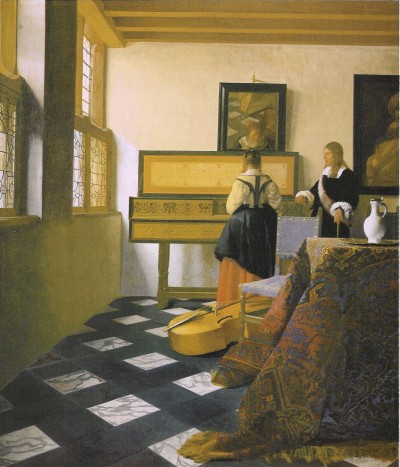
“The Music Lesson.” Collection of Queen Elizabeth II
(Click here to see a larger version.)
In this examination of Vermeer and Austen, I will begin in each case with a Vermeer canvas, analyzing the structure and composition, and then pair it with a scene composed by Jane Austen that is suggested by Vermeer’s painting. My goal is to explain the meticulous manner in which Vermeer bends the physical world to his compositions and to discuss Austen’s comparable artistry in the composition of her novels.
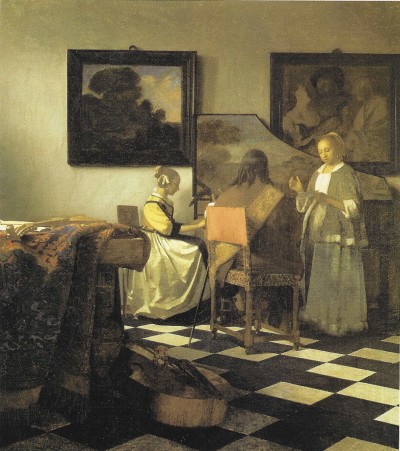
“The Concert.” Isabella Stewart Gardner Museum, Boston, MA
(stolen, whereabouts unknown)
(Click here to see a larger version.)
This painting, commonly called “The Concert,” demonstrates the way in which Vermeer focuses on women as the “main characters” in his work. He achieves that effect through the construction of sight lines and the purposeful placement of objects. In this canvas the eye is drawn to the group of figures—a man and two women—on the far side of the room by the sunlit horizontal of the table in the foreground and the floor tiles, which point like arrows to the trio at the instrument, a clavecin. The man faces the back wall with his chair oddly turned sideways, creating a diamond-shaped footprint, which aligns with the tiles and directs the eye around him and toward the women on either side, who are bathed in light. The man is almost invisible, except for the sash of the lute across his back, which angles upward toward the face of the singer. The curved lid of the clavecin leads to the singer’s face, but Vermeer changed the shape of the lid as it went behind the singer to minimize it. The bass viol on the floor and the lute sitting on the carpeted table develop the painting’s musical theme but also add to the structure: they are placed parallel to the crisscross direction of the tiles, with the lute positioned to lead the eye to the seated woman. The result is that all sight lines point to the women.
As this analysis shows, the painter reveals his priorities through the composition of the picture. Similarly, Austen creates scenes that contribute to a novel’s overall structure by placing her characters in carefully constructed encounters that develop her themes. Vermeer’s painting of “The Concert” pairs nicely with the concert scene at the Coles’ in Emma, which takes place on the day after a square pianoforte is delivered to Jane Fairfax. Gathering her characters around the Coles’ new pianoforte, Austen allows Highbury society to conjecture on the identity of Jane’s unknown benefactor. One of Austen’s major themes in Emma—in fact, in all the novels—is the necessity of self-knowledge and the deleterious effect of self-deception. That theme is given a full airing during the party at the Coles’ and is touched on in this description of the concert, in which two women and a man perform, as in the Vermeer painting.
Mr. Cole entreats Miss Woodhouse to try the new instrument:
[A]s, in every respect, it suited Emma best to lead, she gave a very proper compliance.
She knew the limitations of her own powers too well to attempt more than she could perform with credit; she wanted neither taste nor spirit in the little things which are generally acceptable, and could accompany her own voice well. One accompaniment to her song took her agreeably by surprise—a second, slightly but correctly taken by Frank Churchill. Her pardon was duly begged at the close of the song, and everything usual followed. He was accused of having a delightful voice, and a perfect knowledge of music; which was properly denied. . . . They sang together once more, and Emma would then resign her place to Miss Fairfax, whose performance, both vocal and instrumental, she never could attempt to conceal from herself, was infinitely superior to her own.
With mixed feelings, she seated herself at a little distance from the numbers around the instrument, to listen. Frank Churchill sang again. They had sung together once or twice, it appeared, at Weymouth. . . . Towards the end of Jane’s second song her voice grew thick.
“That will do,” said [Mr. Knightley], when it was finished, thinking aloud—“You have sung quite enough for one evening—now, be quiet.”
Another song, however, was soon begged for. . . . Frank Churchill was heard to say, “I think you could manage this without effort; the first part is so very trifling. The strength of the song falls on the second.”
Mr. Knightley grew angry.
“That fellow,” said he, indignantly, “thinks of nothing but shewing off his own voice. This must not be.” (227–29)
This is a realistic description of gentry life that we experience as though present in the Coles’ drawing-room. But no detail is arbitrary or superfluous, from the opening words—“It suited Emma best to lead”—to the offhand suggestion, “They had sung together once or twice, it appeared, at Weymouth.” Emma’s private self-evaluation is honest, but it is clear that she intends to maintain her social supremacy over Jane Fairfax. In the depiction of Frank’s behavior during the concert and Mr. Knightley’s anger at the close, Austen plants suspicions and offers clues—including, of course, red herrings—to the mystery that will unfold. Earlier in the evening Mrs. Weston had told Emma that she believed Mr. Knightley sent the pianoforte and that he is in love with Jane. The reader is thus led to wonder whether love is the source of Mr. Knightley’s concern for Jane and his irritation with Frank Churchill.
The visual artist and the literary artist consciously direct the gaze of their audience to achieve their creative aims. Vermeer constructs “The Concert” to focus the viewer’s eyes on the women in the picture, though most people are unconscious of his subtle manipulation. In Emma, Austen similarly constructs sight lines and manipulates the reader’s gaze. The story is told by an omniscient narrator, but through the masterful use of free indirect discourse, Austen weaves in and out of the mind of Emma Woodhouse, directing the reader to see people and events through Emma’s eyes and to adopt Emma’s point of view. Many readers are no more conscious of Austen’s authorial manipulation than are viewers of Vermeer’s painting. Austen and Vermeer thus employ comparable techniques to capture and focus the audience’s perception.
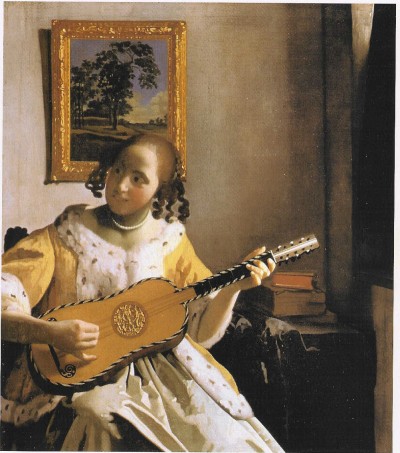
“The Guitar Player.” The Iveagh Bequest, Kenwood House, London
(Click here to see a larger version.)
Another subject shared by Vermeer and Austen is that of women playing keyboard or stringed instruments. The image is common because in the seventeenth and eighteenth centuries single women were expected to display themselves in the marriage market by performing—exhibiting both physical beauty and musical accomplishment. This painting by Vermeer, commonly called “The Guitar Player,” shows a young woman seated near a light source that highlights her shapely, delicate fingers and makes her satin jacket glow. The pearl necklace delineates her smiling face, which is turned toward a listener and tilted in a flirtatious manner, possibly in dialogue with a suitor. The girl is placed off center and to the left on the canvas, further suggesting the presence of an unseen companion near her. An idyllic landscape on the wall frames her face in gold and introduces the natural world into the enclosed setting. In this small painting, Vermeer creates a realistic character and dramatizes a moment in her life.
Austen’s most striking depiction of seduction by musical performance is Mary Crawford with her harp in Mansfield Park. Commentators have pointed out the particular seductions inherent in playing a harp: the woman embraces the instrument, plays with her arms extended and fingers moving rapidly over the strings, and exposes her ankles as she works the pedals (Wells 108). Austen describes Miss Crawford and her harp as seen by Edmund Bertram on a visit to Dr. and Mrs. Grant’s parsonage:
The harp arrived, and rather added to her beauty, wit, and good humour, for she played with the greatest obligingness, with an expression and taste which were peculiarly becoming, and there was something clever to be said at the close of every air. . . . A young woman, pretty, lively, with a harp as elegant as herself; and both placed near a window, cut down to the ground, and opening on a little lawn, surrounded by shrubs in the rich foliage of summer, was enough to catch any man’s heart. The season, the scene, the air, were all favourable to tenderness and sentiment. Mrs. Grant and her tambour frame were not without their use; it was all in harmony; and as every thing will turn to account when love is once set going, even the sandwich tray, and Dr. Grant doing the honours of it, were worth looking at. (64–65)
Austen’s choice of words indicates that she is painting a picture—or, rather, showing Mary Crawford consciously composing a seductive tableau. In this tableau, Mary and her harp are “placed” to great advantage near a tall open window, which, like the landscape painting in Vermeer’s canvas, brings nature into the room. Even homely details are “not without their use” in constructing the scene and can be “turn[ed] to account” to create “harmony,” whose double meaning encompasses both the music and the congenial atmosphere. Edmund is the viewer, and the scene is expressly drawn from his perspective—it was “enough to catch any man’s heart.” Austen is both describing Edmund’s growing admiration of Mary Crawford and setting the stage for Fanny Price’s later, uncomfortable reaction to Mary’s performance in the same room. During Fanny’s visit, Mary expressly invokes that earlier scene when she presses Fanny to stay longer and hear Edmund’s “prime favourite” piece (207). A painter like Vermeer is able to capture a dramatic moment in one well-constructed canvas, while a novelist like Austen works on a large canvas, creating a world with related scenes and characters.
A number of Vermeer’s paintings appear to tell a story. As one art critic says, “An essential element of Vermeer’s poetic imagery is the universal that he reveals within the realm of the everyday, through his distinct manner of painting and his careful choice of narrative moment” (Wheelock et al. 186). In other paintings, Vermeer’s choice of a narrative moment reveals a moral stance.
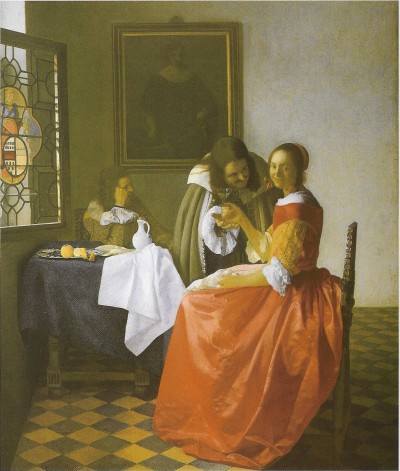
“The Girl with a Wineglass.”
Herzog Anton Ulrich Museum, Brunswick, Germany
(Click here to see a larger version.)
The painting known as “The Girl with a Wine Glass” appears to be a seduction scene in which a girl is plied with wine by a hovering rake, while their companion—perhaps an unsuccessful suitor—nods off in the background. The girl, who turns in her chair to face the viewer with a frank and easy smile, seems to be an active participant in the seduction and not a victim. It is both a realistic portrait and a depiction of the girl’s frame of mind—the psychology underlying her action. Unlike most windows in Vermeer’s paintings, which are usually closed or slightly ajar, this window opens inward to reveal colored glass panes with the allegorical figure of Temperance holding a bridle. Vermeer thus includes an implicit moral lesson in the picture: one should conduct one’s life with temperance and moderation (Wheelock 70). The painting tells a story enacted by well-defined characters and conveying a moral tenet.
The Austen characters suggested by this painting might be Willoughby and Eliza Williams in Sense and Sensibility or Wickham and Miss Darcy in Pride and Prejudice. But, as those seductions take place off stage and involve innocent victims, I have chosen Austen characters who are more like those in the painting: Maria Bertram and Henry Crawford. During the visit to Sotherton, Maria, Henry, and Fanny Price wait near a locked gate for Mr. Rushworth to bring the key. Maria, sparring with Mr. Crawford about the fine time he had with Julia during the drive to Sotherton, says:
“Naturally, I believe, I am as lively as Julia, but I have more to think of now.”
“You have undoubtedly. . . . Your prospects, however, are too fair to justify want of spirits. You have a very smiling scene before you.”
“Do you mean literally or figuratively? Literally I conclude. Yes, certainly, the sun shines and the park looks very cheerful. But unluckily that iron gate, that ha-ha, give me a feeling of restraint and hardship. I cannot get out, as the starling said.” As she spoke, and it was with expression, she walked to the gate; [Henry] followed her. “Mr. Rushworth is so long fetching the key!”
“And for the world you would not get out without the key and without Mr. Rushworth’s authority and protection, or I think you might with little difficulty pass round the edge of the gate, here, with my assistance; I think it might be done, if you really wished to be more at large, and could allow yourself to think it not prohibited.”
“Prohibited! nonsense! I certainly can get out that way, and I will. Mr. Rushworth will be here in a moment you know—we shall not be out of sight.” . . .
Fanny, feeling all this to be wrong, could not help making an effort to prevent it. “You will hurt yourself, Miss Bertram,” she cried, “you will certainly hurt yourself against those spikes—you will tear your gown—you will be in danger of slipping into the ha-ha. You had better not go.”
Her cousin was safe on the other side, while these words were spoken, and smiling with all the good-humour of success, she said, “Thank you, my dear Fanny, but I and my gown are alive and well, and so good-bye.” (99–100)
There is no passage in Austen’s novels so loaded with symbolism and double entendre. Fanny’s role is similar to that of the figure of Temperance in Vermeer’s painting. She sits near the locked gate through which a prudent woman should not pass without her authorized betrothed. An unauthorized man tempts the woman to circumvent the spiked gate, risking bodily harm and a plunge into the abyss (the ha-ha) to roam with him at large. The woman ignores the prudent figure and, aided by the man, escapes the restraint of the iron bars. Maria compares herself to the starling imprisoned in a cage from Laurence Sterne’s A Sentimental Journey. Susannah Fullerton, in Jane Austen and Crime, makes the point that, while Mr. Rushworth is zealous against poachers of his game birds, he fails to detect Henry Crawford right under his nose poaching his betrothed, who, in fact, compares herself to a bird (135). Mr. Rushworth is like the sleeping man in Vermeer’s painting. Austen creates both a fully realized scene and a carefully constructed foretelling of Maria’s ultimate fall from grace caused by her unbridled passion and undisciplined character, traits she shares with Henry. In this passage, Austen’s working method is similar to Vermeer’s in both subject and underlying philosophy. And, like Vermeer, Austen is as concerned with the psychology of her characters as she is with their appearance and actions.
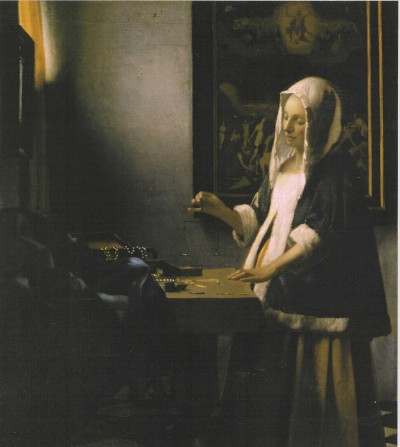
“Woman Holding a Balance.” National Gallery of Art, Washington, D. C.
(Click here to see a larger version.)
Perhaps Vermeer’s most explicitly moral genre painting is “Woman Holding a Balance.” A woman dressed in the blue and white colors of the Virgin Mary stands at a table testing the equilibrium of an empty balance before adding weights. She appears to be pregnant, suggesting a maternal figure like Mary. The painting on the back wall, framing the woman, is “The Last Judgment,” in which Jesus sits in heaven (positioned directly above the woman’s head), preparing to weigh and judge the souls below. Commentators suggest that the mirror on the wall facing the woman represents self-knowledge and that the empty scales represent a current state of equilibrium (Wheelock et al. 142). The jewels spread over the table are a reference to the vanity of worldly possessions. This is a so-called “vanitas” painting, emphasizing the unimportance of fleeting life on earth as opposed to the eternity of the soul. The scales held by the woman will move in one direction or the other depending on the woman’s choices—on her exercise of judgment. The painting thus embodies the oldest concern of Western philosophy: how should one live a good life? Vermeer’s answer is expressed in terms of Christian values, but it is not clear what the woman’s choice will be.
Vermeer’s painting brings to mind the most virtuous of Austen’s women—Fanny Price. Mansfield Park is the novel in which Austen directly engages the question of how one should live a good life. As the characters make choices in answer to that question, it is their good or bad judgment that determines their fate. The words “judge” and “judgment” occur again and again in the novel. The plot is driven by the lax judgment of Sir Thomas, Maria Bertram, and Henry Crawford; the selfish, prejudiced judgment of Mrs. Norris; and the vacillating judgment of Edmund. But the heavy lifting falls to Fanny, the one person who consistently exercises good judgment. Recognizing Fanny’s clear vision, Edmund seeks her out before the Mansfield ball to ask her opinion of Mary Crawford (MP 268–69). Henry Crawford, during his visit in Portsmouth, asks Fanny’s advice concerning his trip home, saying, “‘Your judgment is my rule of right’” (412). Fanny’s judgment is most crucially tested in the question central to her own life—whether to accept Henry’s proposal. Despite pressure from all sides to marry Henry, Fanny stands firm in her choice to remain single rather than marry an unprincipled man whom she neither loves nor respects. Like Vermeer, Austen delves into her characters’ inner lives as she realistically chronicles their worldly story.
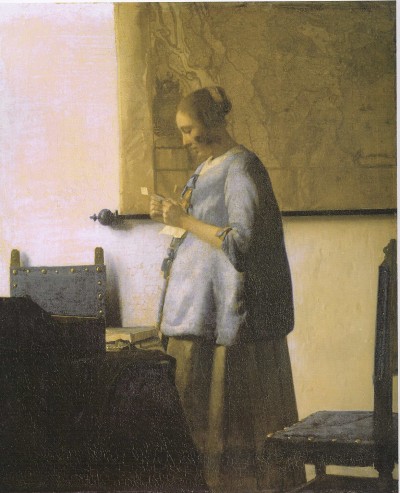
“Woman in Blue Reading a Letter.” Rijksmuseum, Amsterdam, The Netherlands
(Click here to see a larger version.)
My final side by side analysis of narrative moments from Vermeer and Austen focuses on a lady reading a letter, a subject that appears many times in both Vermeer’s and Austen’s work. Vermeer places the lady in the exact center of the canvas. In fact, X-ray examination has shown that he painted and then changed the shape of her blue jacket and the position of the map so that the width of white wall on the left is equal to the width of wall on the right. As we have seen, Vermeer moved objects in this way to achieve his desired effect. Furniture is positioned in front of the woman, placing her at a distance and emphasizing her solitude as she reads what appears to be the second page of a letter. While the chair and map cast shadows on the back wall, the woman casts no shadow, further removing her from the temporal framework of the scene (Wheelock et al. 136). Another page of the letter lies on the table, on top of a pearl necklace—suggesting that the letter is more important than the jewels. The map on the wall serves two narrative purposes: it suggests that the letter-writer is away on a trip, and it alludes to contemporary events beyond the canvas, such as the Dutch navy’s armed conflicts and the overseas trading of rich Dutch merchant ships.
Austen employs a similar, oblique technique to bring the outside world into her domestic comedies. In Pride and Prejudice she quarters the militia in Meryton and in Brighton—allusions to the threat of a French invasion—and in Persuasion she has the Musgrove girls consult the Navy List, allowing Captain Wentworth to relate his adventures at sea. We could consider this painting alongside any number of Austen women absorbed in letters: Elizabeth Bennet with Darcy’s letter of self-defense; Emma with Frank Churchill’s explanation of his secret engagement; or Fanny Price, fearing the postman’s knock in Portsmouth and reading letters from Mary Crawford and Edmund. I have chosen a narrative moment from Persuasion that combines the drama of a woman receiving an unexpected letter with her absorption as she reads it.
At the White Hart in Bath, Captain Wentworth hurriedly writes a letter, which he leaves on the table in front of Anne Elliot. Though she is not alone in the room, her intensely emotional response as she reads the letter effectively isolates her, like the woman in Vermeer’s painting.
The revolution which one instant had made in Anne, was almost beyond expression. The letter, with a direction hardly legible, to “Miss A. E.—.” was evidently the one which he had been folding so hastily. . . . On the contents of that letter depended all which this world could do for her! . . . [S]inking into the chair which he had occupied, succeeding to the very spot where he had leaned and written, her eyes devoured the following words:
“I can listen no longer in silence. I must speak to you by such means as are within my reach. You pierce my soul. I am half agony, half hope. Tell me not that I am too late, that such precious feelings are gone for ever. I offer myself to you again with a heart even more your own, than when you almost broke it eight years and a half ago. Dare not say that man forgets sooner than woman, that his love has an earlier death. I have loved none but you. Unjust I may have been, weak and resentful I have been, but never inconstant. You alone have brought me to Bath. For you alone I think and plan.—Have you not seen this? Can you fail to have understood my wishes?—I had not waited even these ten days, could I have read your feelings, as I think you must have penetrated mine. I can hardly write. I am every instant hearing something which overpowers me. You sink your voice, but I can distinguish the tones of that voice, when they would be lost on others.—Too good, too excellent creature! You do us justice indeed. You do believe that there is true attachment and constancy among men. Believe it to be most fervent, most undeviating, in
“F.W.” (237)
The letter serves as a soliloquy in which Wentworth is able to give vent to feelings that would sound sentimental if spoken aloud. And Jane Austen is never sentimental.
Of course, Austen’s first draft of the proposal scene in Persuasion did not include Captain Wentworth’s letter. It was set in the Crofts’ apartment in Bath. Wentworth, at the insistence of Admiral Croft, asks Anne whether there is any truth to the report that she is to marry William Elliot because the Crofts are willing to give up their lease of Kellynch if a marriage is planned. After receiving Anne’s steady assurance, “‘There is no Truth in any such report’” (263), Wentworth gains courage:
He had been standing by a chair—. . . he now sat down—drew it a little nearer her—& looked, with an expression which had something more than penetration in it, something softer;—Her Countenance did not discourage.—It was a silent, but a very powerful Dialogue;—on his side, Supplication, on her’s acceptance. (263)
The power of Austen’s revision is clear when the two passages are compared. Like Vermeer, who reworked his paintings to achieve the perfect balance, Austen revised the novel and replaced this “silent . . . Dialogue” with Wentworth’s heartfelt declaration of love in a letter. None of her other heroes is allowed to declare his love in such a lengthy and emotional outpouring. The letter provided Austen with the perfect structure for her purpose.
![]()
Walter Scott compared the work of Austen to “the Flemish school of painting” as a means of describing the way she draws characters from “the current of ordinary life,” “finished up to nature and with a precision that delights the reader.” When Scott’s brief comparison is applied to Austen and the most acclaimed genre painter—Johannes Vermeer—it is clear that the traits shared by the two artists extend beyond their realistic depictions of gentry life. Focusing on women in domestic scenes and social encounters, both artists explore the thoughts and emotions of their characters and the moral dimension of their lives and choices. And while Austen and Vermeer work in different media, their techniques are also similar: both are highly selective in the physical details included in their work, and both bend the physical world and manipulate their audience’s view to achieve their artistic goals. An examination of the two artists side by side illuminates their accomplishments.
ACKNOWLEDGMENT
I would like to thank the anonymous Editorial Board reader and Susan Allen Ford, Editor of Persuasions, for their invaluable assistance. Their guidance and comments helped me transform this essay from a slight entertainment to a cogent argument about the artistry shared by Jane Austen and Johannes Vermeer.
